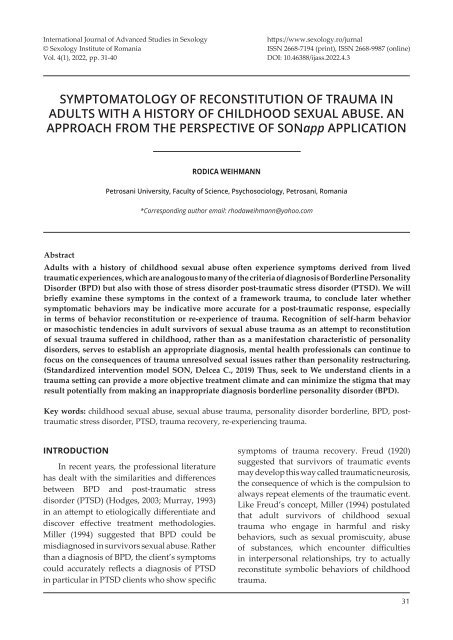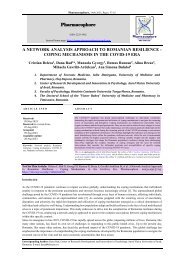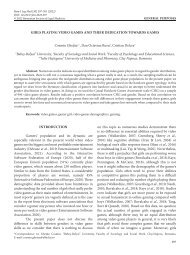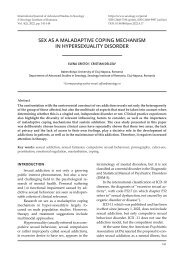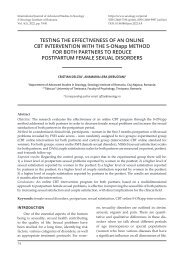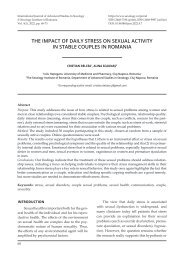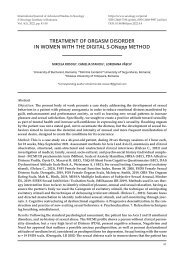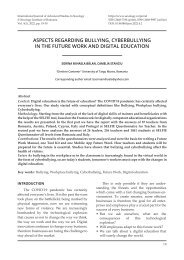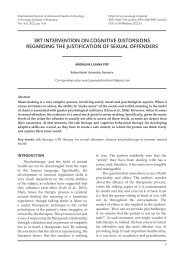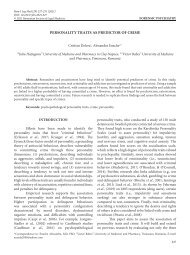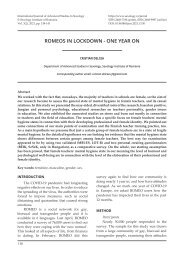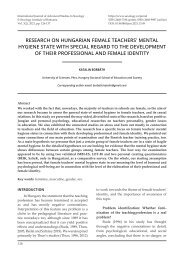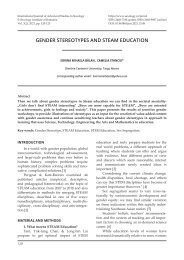SYMPTOMATOLOGY OF RECONSTITUTION OF TRAUMA IN ADULTS WITH A HISTORY OF CHILDHOOD SEXUAL ABUSE. AN APPROACH FROM THE PERSPECTIVE OF SONapp APPLICATION
Adults with a history of childhood sexual abuse often experience symptoms derived from lived traumatic experiences, which are analogous to many of the criteria of diagnosis of Borderline Personality Disorder (BPD) but also with those of stress disorder post-traumatic stress disorder (PTSD). We will briefly examine these symptoms in the context of a framework trauma, to conclude later whether symptomatic behaviors may be indicative more accurate for a post-traumatic response, especially in terms of behavior reconstitution or re-experience of trauma. Recognition of self-harm behavior or masochistic tendencies in adult survivors of sexual abuse trauma as an attempt to reconstitution of sexual trauma suffered in childhood, rather than as a manifestation characteristic of personality disorders, serves to establish an appropriate diagnosis, mental health professionals can continue to focus on the consequences of trauma unresolved sexual issues rather than personality restructuring. (Standardized intervention model SON, Delcea C., 2019) Thus, seek to We understand clients in a trauma setting can provide a more objective treatment climate and can minimize the stigma that may result potentially from making an inappropriate diagnosis borderline personality disorder (BPD).
Adults with a history of childhood sexual abuse often experience symptoms derived from lived
traumatic experiences, which are analogous to many of the criteria of diagnosis of Borderline Personality
Disorder (BPD) but also with those of stress disorder post-traumatic stress disorder (PTSD). We will
briefly examine these symptoms in the context of a framework trauma, to conclude later whether
symptomatic behaviors may be indicative more accurate for a post-traumatic response, especially
in terms of behavior reconstitution or re-experience of trauma. Recognition of self-harm behavior
or masochistic tendencies in adult survivors of sexual abuse trauma as an attempt to reconstitution
of sexual trauma suffered in childhood, rather than as a manifestation characteristic of personality
disorders, serves to establish an appropriate diagnosis, mental health professionals can continue to
focus on the consequences of trauma unresolved sexual issues rather than personality restructuring.
(Standardized intervention model SON, Delcea C., 2019) Thus, seek to We understand clients in a
trauma setting can provide a more objective treatment climate and can minimize the stigma that may
result potentially from making an inappropriate diagnosis borderline personality disorder (BPD).
You also want an ePaper? Increase the reach of your titles
YUMPU automatically turns print PDFs into web optimized ePapers that Google loves.
International Journal of Advanced Studies in Sexology<br />
© Sexology Institute of Romania<br />
Vol. 4(1), 2022, pp. 31-40<br />
https://www.sexology.ro/jurnal<br />
ISSN 2668-7194 (print), ISSN 2668-9987 (online)<br />
DOI: 10.46388/ijass.2022.4.3<br />
<strong>SYMPTOMATOLOGY</strong> <strong>OF</strong> <strong>RECONSTITUTION</strong> <strong>OF</strong> <strong>TRAUMA</strong> <strong>IN</strong><br />
<strong>ADULTS</strong> <strong>WITH</strong> A <strong>HISTORY</strong> <strong>OF</strong> <strong>CHILDHOOD</strong> <strong>SEXUAL</strong> <strong>ABUSE</strong>. <strong>AN</strong><br />
<strong>APPROACH</strong> <strong>FROM</strong> <strong>THE</strong> <strong>PERSPECTIVE</strong> <strong>OF</strong> <strong>SONapp</strong> <strong>APPLICATION</strong><br />
RODICA WEIHM<strong>AN</strong>N<br />
Petrosani University, Faculty of Science, Psychosociology, Petrosani, Romania<br />
*Corresponding author email: rhodaweihmann@yahoo.com<br />
Abstract<br />
Adults with a history of childhood sexual abuse often experience symptoms derived from lived<br />
traumatic experiences, which are analogous to many of the criteria of diagnosis of Borderline Personality<br />
Disorder (BPD) but also with those of stress disorder post-traumatic stress disorder (PTSD). We will<br />
briefly examine these symptoms in the context of a framework trauma, to conclude later whether<br />
symptomatic behaviors may be indicative more accurate for a post-traumatic response, especially<br />
in terms of behavior reconstitution or re-experience of trauma. Recognition of self-harm behavior<br />
or masochistic tendencies in adult survivors of sexual abuse trauma as an attempt to reconstitution<br />
of sexual trauma suffered in childhood, rather than as a manifestation characteristic of personality<br />
disorders, serves to establish an appropriate diagnosis, mental health professionals can continue to<br />
focus on the consequences of trauma unresolved sexual issues rather than personality restructuring.<br />
(Standardized intervention model SON, Delcea C., 2019) Thus, seek to We understand clients in a<br />
trauma setting can provide a more objective treatment climate and can minimize the stigma that may<br />
result potentially from making an inappropriate diagnosis borderline personality disorder (BPD).<br />
Key words: childhood sexual abuse, sexual abuse trauma, personality disorder borderline, BPD, posttraumatic<br />
stress disorder, PTSD, trauma recovery, re-experiencing trauma.<br />
<strong>IN</strong>TRODUCTION<br />
In recent years, the professional literature<br />
has dealt with the similarities and differences<br />
between BPD and post-traumatic stress<br />
disorder (PTSD) (Hodges, 2003; Murray, 1993)<br />
in an attempt to etiologically differentiate and<br />
discover effective treatment methodologies.<br />
Miller (1994) suggested that BPD could be<br />
misdiagnosed in survivors sexual abuse. Rather<br />
than a diagnosis of BPD, the client’s symptoms<br />
could accurately reflects a diagnosis of PTSD<br />
in particular in PTSD clients who show specific<br />
symptoms of trauma recovery. Freud (1920)<br />
suggested that survivors of traumatic events<br />
may develop this way called traumatic neurosis,<br />
the consequence of which is the compulsion to<br />
always repeat elements of the traumatic event.<br />
Like Freud’s concept, Miller (1994) postulated<br />
that adult survivors of childhood sexual<br />
trauma who engage in harmful and risky<br />
behaviors, such as sexual promiscuity, abuse<br />
of substances, which encounter difficulties<br />
in interpersonal relationships, try to actually<br />
reconstitute symbolic behaviors of childhood<br />
trauma.<br />
31
RODICA WEIHM<strong>AN</strong>N<br />
Types of trauma reconstructions in which<br />
these individuals engage may be:<br />
1.) behavioral (harm to oneself or others);<br />
2.) self-destructive (subconscious sabotage<br />
of situations so as to lead to feelings<br />
revictimization);<br />
3.) re-experimentation (flashbacks).<br />
Theoretical aspects<br />
Several theories try to explain the etiology<br />
of these recreational behaviors or reconstitution<br />
of trauma. One of them was proposed<br />
by van der Kolk (1989). He postulated that at<br />
these individuals developed a behavior of dependence<br />
on the traumatic experiences they<br />
suffered and as therefore, they might try to recreate<br />
it (for example, a victim of sexual abuse<br />
in childhood could become a prostitute). Such<br />
individuals have reported feeling flattened, agitated<br />
and even anxious when not experiencing<br />
some form of derived activity from their trauma.<br />
Miller (1994) suggested that this need for<br />
arousal may be an impulse for trauma recreation<br />
behaviors. For children who have experienced<br />
trauma, these experiences have become<br />
synonymous with relationships and the child<br />
is often in a constant state of hyperactivity due<br />
to fear, anger, hyperalert or anxiety. This state<br />
of hyperalert or constant hyperactivity has a<br />
major impact on the child’s biochemistry and<br />
inhibits his recovery at initial homeostasis.<br />
Thus, as adults, individuals may become addicted<br />
to painful emotions, however, for them<br />
it is somewhat pleasant and comforting (for<br />
example, dependent people watching movies<br />
or soap operas with dramatic or tragic action).<br />
Moreover, van der Kolk (1989) reported<br />
that high levels of stress activate opioid systems<br />
in the brain. Just as drugs can activate and<br />
create these systems a cycle of activation and<br />
depression, as could the hyperexcitation that is<br />
created due to trauma. Self-harming behaviors<br />
perpetuate this cycle by producing stimulation<br />
stress-related opioids.<br />
To further support this theory, van der<br />
Kolk stressed the benefits of opioid receptor<br />
blockers in reducing behavior self-mutilating.<br />
Miller (1994) suggested that the process of<br />
reconstructing trauma is cyclical and includes<br />
thoughts, feelings and behaviors that can be<br />
interpreted at different times in the cycle.<br />
At some point, the cycle could be interpreted<br />
as feelings of anger, shame, or intense fear<br />
which could cause an individual to self-harm.<br />
At another point, it could be interpreted that<br />
self-harm causes disgust to others, which could<br />
lead to further punishment, or interprets that<br />
when an interpersonal relationship becomes<br />
too intimate the individual feels the urge<br />
to detach themselves through self-injurious<br />
behaviors. The self-abuse cycle somehow<br />
serves to protecting the trauma survivor<br />
because it keeps others at bay. Function of Selfprotection<br />
of self-harm behaviors is necessary<br />
because survivors are often unable to protect<br />
themselves due to the fact that they usually<br />
maintain diffuse borders in interpersonal<br />
relationships. Paradoxically, they really want to<br />
be saved and protected. Considered together,<br />
these tendencies create relational instability.<br />
In the following we will discuss the impact<br />
of childhood sexual abuse on personality<br />
development and attachment, but also about<br />
how traumatic experiences from childhood can<br />
lead to behaviors of reconstitution of trauma in<br />
adulthood. We will then explore the association<br />
between the symptoms of reconstitution and<br />
the diagnostic categories in DSM 5 of BPD and<br />
PTSD. Then we will be able to see if the use of<br />
BPD diagnosis when treats the survivors of a<br />
sexual trauma, it is the right one, because such<br />
diagnosis may not be clinically accurate, even<br />
having an impact with potentially stigmatizing<br />
or more harmful than beneficial.<br />
The impact of sexual trauma on<br />
personality development<br />
Traumatic experiences in childhood can<br />
hinder the normal developmental process. Janet<br />
(1911) suggested that personality development<br />
is affected by experiences traumatic. As<br />
a result, the individual is unable to adapt and<br />
assimilate new information from experiences,<br />
thus impairing his ability to cope with future<br />
challenges. This thing eventually causes the individual<br />
to become able to integrate the traumatic<br />
material into existing cognitive patterns.<br />
According to Freud (1920), individuals who<br />
32
Symptomatology of reconstitution of trauma in adults with a history of childhood sexual abuse<br />
are not able to assimilate traumatic experiences<br />
in the cognitive system repeats the material<br />
repressed in experiences contemporary and as<br />
van der Kolk (1989) suggests, it is unlikely to<br />
make a connection aware of past experiences<br />
and current reconstructions.<br />
It has been postulated that cognitive distortions<br />
result from sexual trauma suffered in<br />
childhood (Solomon & Heide, 2005). And Owens<br />
and Chard (2001) suggested that these cognitive<br />
distortions have a major impact in these<br />
five areas: security, trust, strength, self-esteem<br />
and privacy. The culminating effect of<br />
such distortions can lead to anxiety, behaviors<br />
avoidance, fear of betrayal, anger, passivity,<br />
feelings of helplessness (Owens & Chard, 2001)<br />
and an exaggerated potential for a sense of<br />
danger (Briere & Runtz, 1993). Bleiberg (1994)<br />
also suggested that sexual abuse may become<br />
part of the struggle conflicts characteristic of<br />
the development process and can fuel fears of<br />
abandonment or feelings of self-alienation and<br />
disconnection from others. A major problem in<br />
the pattern of trauma recovery is the absence<br />
of a presence protective in early relationships,<br />
an absence that affects the individual’s ability<br />
to manifest trust in others, thus impacting the<br />
attachment process and decreasing resilience<br />
of the individual (Miller, 1994; 1996).<br />
According to Liotti and Pasquini (2000),<br />
domestic violence, and here we refer not only<br />
to abuse physically and sexually, but also to<br />
other traumatic conditions, such as witnessing<br />
scenes violence, early separation and loss, neglect,<br />
all these affect the child in his relationship<br />
with the caretaker.<br />
Conceptualizing the implications of malformed<br />
interpersonal relationships due to experiences<br />
traumatic disorders in early childhood,<br />
which result in reconstitution behaviors,<br />
attachment theory is explored in connection<br />
with childhood sexual trauma.<br />
As mentioned above, there is an empirically<br />
supported link between sexual trauma<br />
childhood, attachment disorders and the diagnosis<br />
of BPD in adults. Because of this connection<br />
and symptomatic similarities in BPD and<br />
PTSD, there is the distinct possibility that Early<br />
trauma and attachment difficulties result in an<br />
inadequate diagnosis of BPD. Instead, these<br />
manifestations may be more eloquently reflected<br />
in the reconstruction of the trauma, which<br />
has a greater concordance with the diagnosis<br />
of PTSD.<br />
Attachment<br />
Attachment functions serve to provide<br />
proximity and protection: proximity between<br />
an individual and his or her caregiver and<br />
protection against sexual predators (Bowlby,<br />
1973). In the In essence, the attachment<br />
figure becomes a safe base for children to go<br />
exploring the world and return. A secure<br />
foundation is crucial for development as it<br />
promotes self-confidence, autonomy, empathy<br />
and existential significance. The absence of<br />
this secure basis may even have an impact on<br />
biological development (van der Kolk, 1989),<br />
as a highlights psychosocial dwarfism, the<br />
phenomenon in which children in extremely<br />
stressful environments develops aberrant<br />
behaviors and growth retardation (Powell,<br />
Brasel, & Blizzard, 1967).<br />
Van der Kolk (1987) suggested that the<br />
earliest and possibly the most harmful trauma<br />
psychological is the loss of a secure base. When<br />
those who should be the sources of safety and<br />
of care becomes a source of danger at the same<br />
time, children strive to restore a certain feeling<br />
safe and often blaming themselves instead of<br />
coming back against their caregivers (van der<br />
Kolk, 1989). In fact, children strive to maintain<br />
their parents’ perception of being good at coping<br />
with intense negative emotions, such as<br />
fear and anger, which often accompany sexual<br />
abuse. It is a normal process for individuals<br />
to intensify attachment in response to a threat<br />
(van def Kolk, 1989). We have as an example<br />
the Stockholm syndrome, in which the victims<br />
of the situations of hostages begin to identify<br />
and empathize with their captors (Gachnochi<br />
& Skunik,1992).<br />
When caregivers become a source of danger<br />
and torture, children can develop strong<br />
emotional ties with them. The traumatic connection<br />
legitimizes the behaviors and inappropriate<br />
requests from the perpetrator and thus<br />
can give the victim a sense of reconciliation. If<br />
33
RODICA WEIHM<strong>AN</strong>N<br />
a caregiver rejects and abuses them, children<br />
may become hyperactive due to it.<br />
Conflicting negative emotions and<br />
increased attachment, and the resulting cycle of<br />
over-excitation and reconciliation, can function<br />
as a hardener (van der Kolk, 1989). In adult<br />
survivors of sexual abuse, hyperexcitation<br />
often interferes with their ability to be calm and<br />
rational, and thus preventing the assimilation<br />
of traumatic material. The adult survivor then<br />
responds to anything threats as emergencies,<br />
which require action rather than thinking (van<br />
der Kolk, 1989).<br />
Childhood sexual abuse disrupts the natural<br />
process of attachment, leaving individuals<br />
with inadequate interpersonal skills and often<br />
leading to patterns of behavior disruptive and<br />
unhealthy (Liem & Boudewyn, 1999). Inconsistent<br />
parental care, which is characteristic of<br />
unresolved attachment, establishes a reception<br />
and a coding in short circuit of relational stimuli<br />
in the child. According to Koos and Gergely<br />
(2001), inconsistency demonstrated in the process<br />
of raising the child leads to a “dissociative<br />
style of attention and behavioral organization<br />
characteristic of the disorganized attachment of<br />
the infant”. This one Primary inconsistency in<br />
care seems to be a logical precursor to emotional<br />
attachment, of also inconsistent, manifested<br />
by individuals with BPD in adult interpersonal<br />
relationships (Holmes, 2004). Herman (1999)<br />
suggested that the main difficulty for those diagnosed<br />
with BPD is their lack of confidence in<br />
people, which may come from a lack of a cognitive<br />
pattern integrated and based on a reliable<br />
source of trust, but which was not formed<br />
in childhood.<br />
Liotti and Pasquini (2000) demonstrated the<br />
similarities between BPD and its subsequent<br />
effects disorganized attachment to personality<br />
development, emphasizing that both BPD and<br />
Disorganized attachment are characterized<br />
by an unintegrated representation of the self<br />
with others, individuals with weak emotional<br />
drive and control and a penchant for experience<br />
dissociative. The effect of this fragmented<br />
process is a lack of clear boundaries as well as<br />
feelings of uncertainty about the security of<br />
relationships with others (Miller, 1994).<br />
In individuals experiencing trauma, this<br />
is evidence of attachment inconsistent that<br />
will influence their future relationships. Miller<br />
(1996) described the spectator unprotected as a<br />
parental figure who ignored the occurrence of<br />
sexual abuse.<br />
Lack of protection from the unsecured<br />
viewer has a significant impact on the attachment,<br />
the consequences being the inability to<br />
protect oneself and to calm oneself. This inability<br />
it will determine a fragmented personality,<br />
in which the individual is incapable of perceiving<br />
himself as a whole person, thus relating<br />
to others in fragmented parts. Reconstruction<br />
of trauma in adulthood once an individual<br />
has been abused, he or she will never be able<br />
to perceive himself or herself the world in the<br />
same way as before abuse, because all future<br />
experiences will be rebuilt through the filter of<br />
abuse (van der Kolk, 1989). This filter is connected<br />
to the cognitive processes of assimilation<br />
and accommodation identified by Piaget.<br />
Piaget (1970) described assimilation as<br />
the integration of experiences into cognitive<br />
schemas existing and the adaptation with<br />
modification of the schemes by the assimilated<br />
experiences. Van Geert (1998) later described<br />
the process of assimilation as the way the<br />
world is understood in depending on the level<br />
of cognitive development of the individual at<br />
the time of experience and accommodation<br />
with the way the individual adapts to the<br />
reality of the experience. Thus, when a child<br />
experiencing sexual trauma, he or she will<br />
assimilate the experience depending on his or<br />
her level of cognitive development and then<br />
will adjust to that experience. Because the<br />
development of the process of assimilation and<br />
accommodation has such an impactsignificantly<br />
on cognitive patterns, adults may continue to<br />
behave or to think in accordance with these<br />
schemes. For example, victims of past trauma<br />
may responds to contemporary events as if<br />
the trauma had returned and re-experienced<br />
the hyperexcitation that accompanied the<br />
initial trauma. Van der Kolk (1989) suggested<br />
that the adult trauma survivor seeks to erase<br />
the past through exemplary behavior, love<br />
and competence. If the individual fails to heal<br />
34
Symptomatology of reconstitution of trauma in adults with a history of childhood sexual abuse<br />
his trauma, self-blame reappears along with<br />
a return to previous self-destructive coping<br />
mechanisms.<br />
Doob (1992) suggested that there is an<br />
apparent link between the reconstitution of<br />
trauma through borderline pathology and the<br />
history of sexual trauma in the accommodation<br />
process. Victims of abusechronically accepts<br />
the initial abuse as an adaptive survival<br />
strategy, denying its existence and changing<br />
their emotional responses to abuse and thought<br />
processes those who should have protected<br />
them, instead harmed them. Finally, these<br />
strategies result in the victim experiencing<br />
anger, which is redirected to himself and thus<br />
results in self-injurious behavior.<br />
It turns out that self-harm is essentially a<br />
behavior of reconstructing history traumatic<br />
client. This strategy allows the abused child<br />
to stay connected with family members.<br />
However, as adults, these accommodations,<br />
which manifest through dissociative<br />
symptoms, self-destruction, irrational anxiety,<br />
interpersonal conflicts, behaviors and paranoid<br />
ideation, depression and anxiety, are seen as<br />
psychopathology in mental health community,<br />
rather than as adaptive skills.<br />
Borderline personality disorder and<br />
childhood sexual abuse<br />
Research shows that attachment disorders<br />
and relationships or interpersonal relationships<br />
with early childhood referrals affect personality<br />
development and healthy interpersonal<br />
functioning as an adult, often leading to the<br />
development of disorders personality, such as<br />
BPD (Adams, 1999; Mahler, 1971). Marked by<br />
a pattern of instability relationship problems,<br />
identity disorders, impulsivity, suicidal ideation<br />
or suicide attempts, reactive mood swings,<br />
chronic feelings of emptiness, inadequate anger<br />
and / or uncontrolled and often explosive,<br />
contradictory feelings and severe dissociative<br />
episodes (APA, 2013), people with BPD seem<br />
to be driven by a paradoxical search for close<br />
relationships and they are constantly being<br />
sabotaged. Of course, the primary deficit in<br />
the disorder borderline personality has been<br />
described as a “failure to achieve the constancy<br />
of the object ... a failure to form reliable and<br />
well-integrated inner representations with<br />
trusted people” (Herman, 1999).<br />
A number of researchers have found<br />
that a significant number of individuals are<br />
diagnosed with BPDs have a history of sexual<br />
and physical abuse in childhood (Goldman,<br />
D’Angelo, & DeMaso, 1993; Herman, Perry and<br />
van der Kolk, 1989; Herman & van der Kolk),<br />
1987; Zanarini, Frankenburg, Reich and Marino,<br />
2000). Sexual-physical trauma that occurs as a<br />
result of sexual abuse childhood contributes<br />
to an interpersonal style of functioning that<br />
involves manipulative relationships, addicted<br />
and a chronic low self-esteem. Terr (1991)<br />
suggested that children exposed to experiences<br />
of trauma have changed their attitudes towards<br />
interpersonal relationships, experiences of<br />
life and difficulties related to their ability to<br />
consider the effects of this on of the future.<br />
Many individuals with these characteristics<br />
eventually end up resorting to psychotherapy<br />
and are diagnosed with BPD.<br />
However, although it is possible, and often<br />
likely, that the symptoms of the trauma survivor<br />
to be somewhat similar to the diagnostic<br />
criteria for BPD, it is imperative to take into<br />
account consider the basic motivators, represented<br />
in the symptoms, before giving a diagnosis<br />
of BPD. These basic motivators are often<br />
the result of avoiding abuse to deal with trauma<br />
and eventually lead to the development of<br />
strategies maladaptive adaptations. The result<br />
of avoiding stimuli associated with childhood<br />
trauma, inclusive increased excitement and<br />
re-experiencing trauma, are distinct behaviors<br />
that characterize victims’ responses to sexual<br />
trauma (Morgan, Rigaud, & Taylor, 1990), and<br />
therefore, they are more in line with the diagnostic<br />
criteria for PTSD. In addition, when Sexual<br />
boundaries are invaded during experiences<br />
of sexual trauma, strategies of Psychological<br />
adaptation of the victims helps to suppress<br />
overwhelming emotions and thoughts related<br />
to trauma.<br />
Repression and dissociation allow victims<br />
to cope with experiences they cannot integrate,<br />
and when repression and dissociation begin<br />
to fail as coping mechanisms, individuals<br />
35
RODICA WEIHM<strong>AN</strong>N<br />
may re-experience traumatic events (Morgan,<br />
Rigaud & Taylor, 1990). Many Victims face the<br />
“breakdown of the avoidance response” by reexperiencing<br />
all or some aspects of their sexual<br />
trauma. For example, people may experience<br />
intrusive flashbacks to sensations, including<br />
sounds, smells, or tastes that were present<br />
at the time. incident of abuse. As a result of<br />
re-experiencing the trauma, the individual<br />
may become confused and can cause intense<br />
emotions that can lead to misdiagnosis. These<br />
answers are similar to BPD’s characteristics of<br />
emotional instability, inappropriate anger, or<br />
ideation paranoid stress-related. If we consider<br />
these characteristics, it seems reasonable to<br />
We believe that the symptoms that often<br />
lead to a diagnosis of BPD may be more<br />
consistent with the recreation of trauma, rather<br />
than with the reflection of personality deficits.<br />
Post-traumatic stress disorder PTSD.<br />
Miller (1994) suggested that distinguishing<br />
symptoms of reconstitution of trauma<br />
from BPD symptoms involve a thorough understanding<br />
of the client’s history. People who<br />
reconstruct and relive childhood traumas often<br />
have a vast history of multiple traumas: physical,<br />
sexual or emotional abuse, neglect and /<br />
or invasive care, chronic behavior challenging<br />
interpersonal and intrapersonal difficulties, as<br />
well as a behavioral pattern self-destructive<br />
harm to personal health and well-being. These<br />
behaviors, though pathological, are mechanisms<br />
of maladaptive coping rather than<br />
symptomatology characteristic of a personality<br />
disorder. Although these characteristics seem<br />
similar to the diagnostic criteria of BPD, the<br />
history of trauma. Childhood sexual dysfunction<br />
is not a prerequisite for the diagnosis of<br />
BPD. However, due to traumatic events, individuals<br />
exhibit reconstructive behaviors.<br />
Since PTSD is one of the few situationally<br />
identified DSM-5 diagnoses, it seems<br />
reasonable to be described in more detail.<br />
Post-Traumatic Stress Disorder is marked<br />
by the following key areas:<br />
1) psychobiological changes (such as<br />
hypervigilance, predisposition to anger,<br />
exaggerated response startle sleep disorders);<br />
2) traumatic memory (eg nightmares,<br />
relapse, imaging intrusive, dissociation);<br />
3) avoidance, numbness and denial (eg<br />
alienation and detachment, substance abuse,<br />
emotional constraint);<br />
4) self-concept, ego states, personal<br />
identity and self-structure (e.g. dissemination<br />
of identity, vulnerability, poor knowledge<br />
about oneself and the world);<br />
5) attachment, intimacy and interpersonal<br />
relationships (eg alienation, self-destructive<br />
relationships, mistrust, borderline problems<br />
with others, impulsivity) (APA, 2013; Wilson,<br />
Friedman and Lindy, 2001).<br />
The diagnostic criteria in the DSM-5 listed<br />
above appear to be similar to those discussed<br />
previously for BPD. In fact, Hodges (2003)<br />
supported the current view that suggests<br />
that BPD is a “chronic form of PTSD that has<br />
been integrated into the personality.” The<br />
idea that PTSD could be a chronic condition<br />
that was originally suggested two decades<br />
ago by Armsworth (1984), who indicated that<br />
survivors of childhood sexual trauma who<br />
PTSD may have persistent symptoms during<br />
adulthood. More recently, Banyard, Williams,<br />
and Siegel (2000) indicated that childhood<br />
sexual trauma may have a chain reaction<br />
of psychological suffering that begins in<br />
childhood and continues throughout life, if the<br />
trauma is not healed. Lang et al. (2003) found<br />
that women with a history of trauma PTSD<br />
had significantly more symptoms than women<br />
without such sex antecedents.<br />
In addition, their findings indicated that<br />
PTSD mediates the relationship between<br />
trauma history and poor health behaviors,<br />
including risky sexual behaviors and substance<br />
abuse. Thompson et al. (2003) also found<br />
significant results statistically, which suggests<br />
that women who suffered sexual trauma<br />
in childhood had more chances of having<br />
symptoms of PTSD than women who have not<br />
suffered such a trauma.<br />
May much, Banyard et al. (2000) found that<br />
childhood sexual trauma is associated with<br />
PTSD symptoms of anxiety, hyperexcitability,<br />
depression, avoidance, intrusions, self-referral,<br />
dissociation, and sexual concerns.<br />
36
Symptomatology of reconstitution of trauma in adults with a history of childhood sexual abuse<br />
Supporting the above assertions, which<br />
suggest that survivors of sexual trauma in<br />
Childhood experiencing PTSD symptoms is<br />
important, but not the key to it understanding<br />
and treating symptoms of reconstitution of<br />
trauma. To provide efficient services survivors<br />
of childhood sexual trauma, the mental health<br />
community must take in consider the underlying<br />
reasons why some survivors experience it<br />
reconstitution behaviors, while others do not,<br />
although little is known about this.<br />
Banyard et al. (2000) suggested that for<br />
some, the symptoms associated with PTSD<br />
become part of it from the structure of their<br />
personality.<br />
If we consider the childhood sexual trauma<br />
of aframework of learning theory, it is logical<br />
that the coping and response models that were<br />
used during the period in which the sexual<br />
trauma took place to be the same coping and<br />
response patterns used in other life situations<br />
and thus increase the risk of problems future<br />
psychology (Banyard et al., 2000).<br />
A reconsideration of borderline<br />
personality disorders<br />
While mental health professionals may<br />
disagree with the theory and origin BPD, few<br />
would argue against the claim that BPD is one<br />
of the most difficult forms of mental illness<br />
to be treated. People with BPD often present<br />
themselves as very manipulative and causes<br />
a certain frustration to therapists in relation<br />
to the cycle of manipulation and rejection<br />
manifested by these customers. Perry (1997)<br />
suggested that health professionals.<br />
People with a diagnosis of BPD often see<br />
the therapist as imposing on the therapist<br />
responsibility for their improvement, but at the<br />
same time rejecting the therapist’s efforts to it<br />
helps. Some sort of stigma associated with this<br />
diagnosis has somehow become commonplace<br />
mental health professionals globally, which<br />
is why BPD often does similar to a kind of<br />
“death sentence” for a client (Gallop, Lancee<br />
and Garfinkel, 1989; Nehls, 1998; Reiser &<br />
Levinson, 1984). In fact, “psychological cancer”<br />
was the term used by Kernberg (1984, p. 262) to<br />
describe the diagnosis of BPD. In a 1988 study<br />
by Lewis and Appleby, psychiatrists were<br />
found to be pejorative, critical, and the patient<br />
with BPD claiming that they were manipulative<br />
and required extreme attention, giving Of<br />
course, they do not deserve the same quality<br />
of care as other patients. Reiser and Levenson<br />
(1984) indicated that the term borderline may<br />
create an interruption of empathy between the<br />
clinician and the client.<br />
Indeed, the diagnostic criteria for BPD are<br />
similar to many of the consequences and longterm<br />
reactions to childhood sexual abuse. For<br />
example, some consequences on Long-term notices<br />
of sexual abuse include affected relationships<br />
and mistrust others, concern for sexual<br />
issues and promiscuity, sexual dysfunction,<br />
and impulsivity risky behaviors (eg substance<br />
abuse, prostitution, behaviors self-destructive),<br />
suicidal ideation and depression (Murray,<br />
1993). However, stigma derived from the diagnosis<br />
of BPD can actually lead to the re-trauma<br />
of the adult survivor of childhood sexual abuse<br />
during therapy. Dobb (1992) suggested that because<br />
adult survivors often continue to “blame<br />
themselves for their victimization, explaining<br />
that they have been abused because of their essential<br />
wickedness “, the label of a personality<br />
disorder may confirms this notion for the adult<br />
who was sexually abused as a child Moreover,<br />
a practitioner focused on a diagnosis of such a<br />
personality disorder BPD will probably focus<br />
on the specific features of that diagnosis and<br />
will not look beyond of character concerns, at<br />
the sources of problems that make the client<br />
repeat patterns behavioral (Miller, 1994). However,<br />
visualizing the client’s struggles from a<br />
trauma framework allows the therapist to see<br />
the symptoms as coping mechanisms for the<br />
history of his trauma and allows the explanation,<br />
in a way perceived as non-threatening<br />
by to the client, how such past experiences are<br />
reactivated by the present choices. Therefore,<br />
this explanation may allow the client to understand<br />
how these behaviors they have served as<br />
maladaptive coping mechanisms that maintain<br />
the status of victim, offering however, at the<br />
same time, the opportunity to learn other more<br />
effective coping mechanisms. This change in<br />
his thinking towards a status of survivor, with-<br />
37
RODICA WEIHM<strong>AN</strong>N<br />
out guilt or revictimization, it is an absolutely<br />
necessary condition.<br />
Although the diagnosis of BPD can be<br />
helpful in identifying behaviors when consult<br />
with other mental health professionals about<br />
the stigma attached to the label can provide<br />
customer service by mislabeling behaviors as<br />
being characterological rather than adaptive<br />
behaviors (Miller, 1994).<br />
Miller and May suggested that a client who<br />
is recovering from childhood trauma should be<br />
understood through exploration maladaptive<br />
behaviors (e.g., self-harm, anger, relationship<br />
turmoil), rather than trying to silence them.<br />
Axis I diagnosis, BPD should be considered<br />
a subclassification of PTSD. In doing so, he<br />
indicated Hodges would reduce the stigma<br />
associated with BPD and integrate two<br />
categories of diagnosis apparently similar.<br />
The complexity of the implications and<br />
needs of the clients who show the symptoms<br />
of reconstitution trauma creates the need<br />
for a comprehensive assessment, treatment<br />
planning and psychotherapeutic intervention.<br />
Therefore, it seems necessary to take a<br />
therapeutic approach integrate emotional,<br />
behavioral and interpersonal awareness.<br />
It is essential to create a secure environment<br />
in which the customer can explore openly<br />
traumatic history. Customers should be helped<br />
to make conscious connections between their<br />
experiences past and reconstitution experiences,<br />
as the recognition of this connection will allow<br />
coping mechanisms to be more adaptable, to<br />
fall into the category of conscious reactions to<br />
stressful events (Miller, 1994).<br />
In order to recreate the cyclical pattern,<br />
clients should begin to recognize the cyclical<br />
pattern maladaptive and often destructive<br />
created when the expressed needs of a client<br />
are not fulfilled as a result of his behaviors.<br />
For subjects facing reconstitution of trauma,<br />
expressions of need (safety, trust, strength,<br />
esteem and privacy) in the way they are<br />
accustomed (reconstitution behaviors)<br />
result in rejection to any attempt by others<br />
to satisfy these needs, thus catching them in<br />
a cycle destructive. Clients who experience<br />
reconstitution of trauma often cause it<br />
simultaneously the closeness and emotional<br />
intimacy of a protective spectator, only to reject<br />
him in the the latter (Miller, 1994).<br />
Therefore, creating awareness and gaining<br />
the ability to satisfying needs through other<br />
more adaptive behaviors becomes the key to<br />
treatment clients facing trauma recreation.<br />
From a cognitive perspective, the<br />
distortions that result from childhood trauma<br />
and which result in anxiety, avoidant behavior,<br />
fear of betrayal, anger, and passivity feelings<br />
of helplessness should be realized and altered<br />
(Owens & Chard, 2001). Customers who<br />
experience the reconstitution of trauma may<br />
think that “their purpose in life” is to always<br />
relive and be punished constantly in response<br />
to the traumatic episode. Furthermore, they<br />
can maintain the cognitive distortion in which<br />
they feel guilty and that the perpetrator is in as<br />
a rule, in an attempt to manage the cognitive<br />
dissonance that results when a caregiver is<br />
simultaneously the source of safety and danger<br />
(Delcea C., Enache A., 2021). These and other<br />
specific beliefs or distortions each individual<br />
client should be challenged and eventually<br />
replaced with other cognitions stronger, selfaware.<br />
Miller (1994) outlines four approaches<br />
to trauma recovery treatment.<br />
In turn, it indicates that understanding<br />
the context surrounding the symptoms of<br />
reconstitution Trauma is fundamental to<br />
understanding and treatment. Miller states<br />
that by context she refers to “situations in<br />
which the person lives, interacts, thinks and<br />
experiences itself in relation to the world”.<br />
Miller suggests that there are several contexts<br />
that support logic ubiquitous reconstitution.<br />
Second, the symptoms should be viewed from<br />
a perspective historical, as an adaptation and<br />
communication of the individual past. In the<br />
third line, behavior should be seen as having<br />
many functions even when that behavior it is<br />
no longer necessary. For trauma victims, the<br />
symptoms become a companion, much less<br />
threatening than other new relationships or<br />
experiences and often their only source of power<br />
and control. Finally, Miller says the victim of<br />
trauma needs recovery at least a meaningful<br />
and healthy relationship before revisiting the<br />
38
Symptomatology of reconstitution of trauma in adults with a history of childhood sexual abuse<br />
traumatic event. This can be achieved most<br />
often in the therapeutic relationship.<br />
In essence, the client who is experiencing<br />
symptoms of trauma abuse Childhood sexual<br />
abuse should be treated comprehensively and<br />
systemically. It would be a disservice major<br />
to treat separately the symptoms or behaviors<br />
that form the recreation trauma. Specifically, it<br />
would certainly be ineffective to treat only the<br />
disorder addiction or eating disorder or selfharming<br />
behavior, separately.<br />
CONCLUSIONS<br />
This summary review of the literature supports<br />
the need to adopt an attitude more cautious<br />
and careful about the differential diagnosis<br />
between BPD and PTSD within diagnostic<br />
practices of mental health professionals when<br />
treats adults who have experienced sexual<br />
trauma in childhood. It seems that the expression<br />
of this trauma of abuse, which often results<br />
in disorganized attachment, manifests itself in<br />
parallel through many symptoms of BPD and<br />
PTSD. Although there are similarities between<br />
the diagnosis of a borderline personality disorders<br />
and trauma reconstitution behaviors, honesty<br />
professional forces the psychotherapist<br />
to carefully assess whether the client’s symptoms<br />
reflect more much PTSD, thus providing<br />
a more effective treatment climate. Due to the<br />
potential of discrimination found in the global<br />
mental health community and the implications<br />
for the environment socio-professional,<br />
it becomes extremely important to determine<br />
whether the client’s symptoms is the result of<br />
unresolved childhood sexual trauma or a real<br />
sexual disorder borderline personality, each<br />
with treatment implications and protocols<br />
unique and different.<br />
BIBLIOGRAPHY<br />
1. Delcea C., S-ON©, an online application<br />
for clinical evaluation and treating sexual<br />
dysfunctions. Int J Advanced Studies in<br />
Sexology. Vol. 1, Issue 1, pp. 5-9. Sexology<br />
Institute of Romania. DOI: 10.46388/<br />
ijass.2019.12.11.1<br />
2. Delcea C., Construction, Validation, and<br />
Standardization of the Sexual-DSMapp<br />
Application; in „Psychiatric Research and<br />
Clinical Practice”, Volume 2, Issue 2, December<br />
2020 Pages 70-75. Wiley Periodicals LLC. on<br />
behalf of the American Psychiatric Association.<br />
3. Adams, K. M. (1999). Sexual harassment<br />
as cycles of trauma reenactment and<br />
sexual compulsivity. Sexual Addiction and<br />
Compulsivity.<br />
4. American Psychiatric Association (2013).<br />
Diagnostic and statistical manual of mental<br />
disorders (5th ed.).<br />
5. Armsworth, M.W. (1984). Post-traumatic stress<br />
responses in women who experienced incest as<br />
children or adolescents. Dissertation Abstracts<br />
International.<br />
6. Banyard, V.L., Williams, L.M., & Siegel,<br />
J.A. (2000). The long-term mental health<br />
consequences of child sexual abuse: An<br />
exploratory study of the impact of multiple<br />
traumas in a sample of women. Journal of<br />
Traumatic Stress.<br />
7. Bleiberg, E. (1994). Borderline disorders in<br />
children and adolescents: The concept, the<br />
diagnosis, and the controversy [Electronic<br />
version]. Bulletin of the Mettinger Clinic.<br />
8. Bowlby, J. (1973). Separation: Anxieties and<br />
anger. London: Penguin Books.<br />
9. Briere, J., & Runtz, M. (1993). Childhood sexual<br />
abuse: Long-term sequelae and implications<br />
for psychological assessment. Journal of<br />
Interpersonal Violence.<br />
10. Diamond, R., & Factor, R. (1994). Taking issue:<br />
Treatment-resistant patients or a treatment<br />
resistant system? Hospital and Community<br />
Psychiatry.<br />
11. Doob, D. (1992). Female sexual abuse survivors<br />
as patients: Avoiding retraumatization.<br />
Archives of Psychiatric Nursing.<br />
12. Freud, S. (1920). Beyond the pleasure principle.<br />
In J. Starchey (Ed.) Complete Psychological<br />
Works (3rd edition). London: Hogarth Press.<br />
13. Gachnochi, G., & Skunik, N. (1992). The<br />
paradoxical effects of hostage taking.<br />
International Social Science Journal.<br />
14. Gallop, R., Lancee, W. J., & Garfinkel, P.<br />
(1989). How nursing staff respond to the label<br />
“Borderline Personality Disorder.” Hospital<br />
and Community Psychiatry.<br />
15. Goldman, S. J., D’Angelo, E. J., & DeMaso,<br />
D. R. (1993). Psychopathology in the family<br />
of children and adolescents with borderline<br />
39
RODICA WEIHM<strong>AN</strong>N<br />
personality disorder. American Journal of<br />
Psychiatry.<br />
16. Herman, J. (1999). Trauma and recovery: The<br />
aftermath of violence from domestic abuse to<br />
political terror. New York: Basic Books.<br />
17. Herman, J. L., Perry, C., & van der Kolk, B.<br />
A. (1989). Childhood trauma in borderline<br />
personality disorder. American Journal of<br />
Psychiatry.<br />
18. Delcea C., Enache A., (2021). Personality Traits<br />
as Predictor of Crime. Rom J Leg Med [29] 2,<br />
227-231 [2021] DOI: 10.4323/rjlm.2021.227.<br />
19. Herman, J. L., & van der Kolk, B. A. (1987).<br />
Traumatic antecedents of BPD. In B.A. van der<br />
Kolk (Ed.) Psychological Trauma. Washington,<br />
D.C .: American Psychiatric Press, Inc.<br />
40


